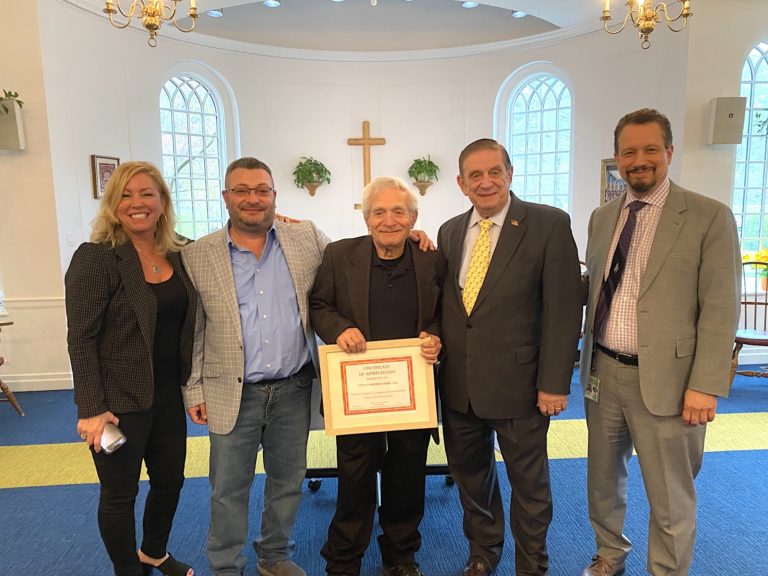
By Francis Ambrogio
Like so many around the world, I was struck profoundly by the burning of the cathedral of Notre Dame de Paris. Anyone who watched the cathedral go up in flames had to be touched, whether they were believers who had prayed there, as I did last May, or if they had simply grown up watching Disney’s “Hunchback of Notre Dame” (sorry, Victor Hugo). Despite its steeple-less bell towers, Notre Dame is the gothic cathedral – indeed, it may be the cathedral – in our popular consciousness.
Think about it – it was in Notre Dame that medieval musicians experimented with polyphony, laying the foundations for modern Western music. It was one of the first cathedrals to employ flying buttresses, architectural features that allowed its builders to make it taller than any buildings had ever been. Those innovative buttresses held the weight of the stone walls so that artisans could install the massive, stunning stained-glass windows that radiated many-colored light into the cathedral. Centuries’ worth of visitors to the cathedral – many, if not most, of whom could not read – were both educated and inspired by those windows and the countless pieces of art and sacred relics that dwelt within.
It is fitting that Notre Dame was constructed during the Middle Ages, when Paris, the capital of France – then known as The First Daughter of the Church – first became a leading center of culture and learning.
Standing alone at the east end of Paris’s Île de la Cité, Notre Dame has borne witness to history, not only of France, but of the entire West. Its burning marks a loss of not only one of the world’s most beautiful edifices, but one of its greatest monuments.
And much was lost. The roof timbers alone were historic treasures. Some dated from the time of Charlemagne (more than a thousand years ago!), and there are no trees left in France today as tall as those old oaks. There were windows dating from the time of Dante that were damaged beyond repair. And we all saw the spire’s dramatic collapse over and over again on our TV screens and live feeds.
But much was saved, and in truly heroic fashion. While the embers still smoldered, stories began to spread of people like Father Jean-Marc Fournier, the chaplain of the Paris Fire Brigade, who insisted on being allowed into the burning cathedral in order to rescue the relics and the Blessed Sacrament from the church’s tabernacle. He led firefighters in creating a human chain to move the holy items out of the inferno.
It is worth noting that Fr. Fournier saw combat with the French Army in Afghanistan, and that four years ago, he was among the first to rush into the Bataclan Theater after ISIS adherents gunned down 89 people inside. If you don’t believe in heroes, consider yourself proven wrong.
The first photo released showing the inside of Notre Dame after the fire was nothing short of amazing – perhaps miraculous. Through the smoke, ashes, and rubble, the cross above the altar shone brightly and the pietà beneath it stood untouched.
Almost immediately, people on the internet captioned it with the last words of Joan of Arc, the young woman who led France’s armies to victory after victory, and upon being taken prisoner was wrongfully burned at the stake: “Hold the Cross high, so I may see it through the flames!”
Which brings us to the question of how Notre Dame emerges from this catastrophe. How do we rebuild something like that?
Thankfully, people from across the world pledged their support for Notre Dame’s restoration almost before the fire was out. Despite the bitter social and political divisions that we see blasted across screens every day (usually intended to get clicks or likes), every person who saw the ancient cathedral of Notre Dame on fire paused in sadness. All seem to agree that Notre Dame, a crown jewel for so many – Paris, France, the West, the Christian faith, artists, musicians, architects, all of humanity – must be restored to its former glory.
This restoration will be a massive undertaking, just as the cathedral’s original construction was – it took almost two centuries to build! But such grand projects are worth it, because they transcend the mundane and inspire all who behold them. One 20th century French monk remarked that the “majesty of temples, the splendor of liturgy, and the sweetness of chants…[form] an earthly epiphany accessible to all.” Things like Notre Dame outlast all of us, in the shortness of our lives, and they leave a legacy of collective commitment to things far greater than any individual person. Robert Barron, a current Catholic bishop of Los Angeles who gave tours of the cathedral when he was a theology student in Paris, also commented on the universal and enduring appeal of Notre Dame. He noted that the crowds of people who stopped as they saw the cathedral burn, dropped to their knees, and began singing the same Ave Maria that their ancestors prayed when the cathedral was being built almost a millennium ago, “are the ones who most got what that building means…If it survives, it’s because of that. And that’s the thing that maybe is most hopeful about it.”




